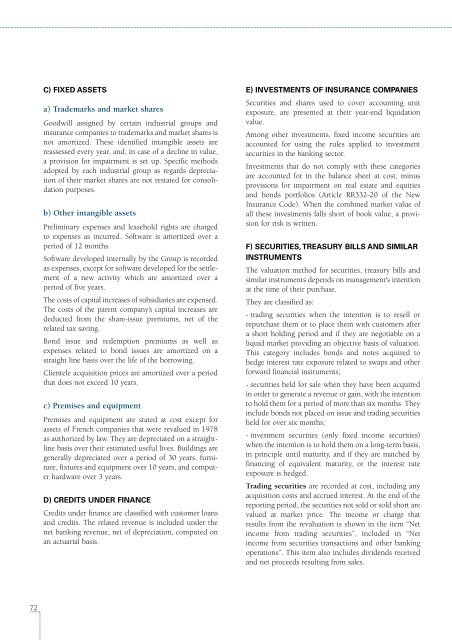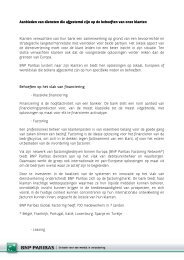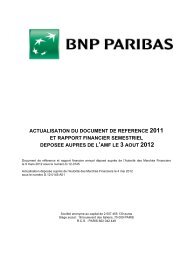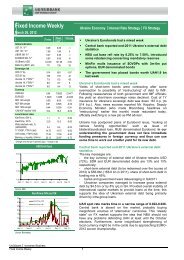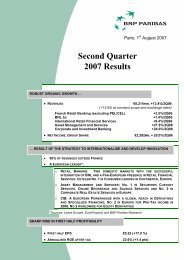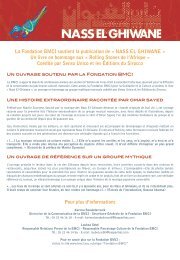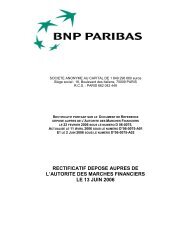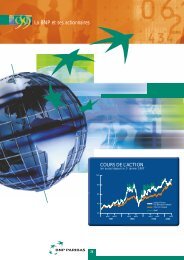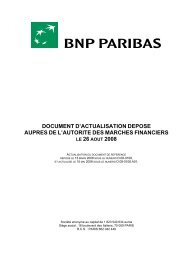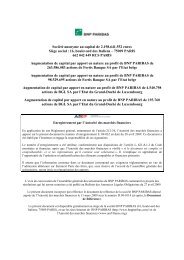1998-Paribas Annual Report - BNP Paribas
1998-Paribas Annual Report - BNP Paribas
1998-Paribas Annual Report - BNP Paribas
Create successful ePaper yourself
Turn your PDF publications into a flip-book with our unique Google optimized e-Paper software.
72<br />
C) FIXED ASSETS<br />
a) Trademarks and market shares<br />
Goodwill assigned by certain industrial groups and<br />
insurance companies to trademarks and market shares is<br />
not amortized. These identified intangible assets are<br />
reassessed every year, and, in case of a decline in value,<br />
a provision for impairment is set up. Specific methods<br />
adopted by each industrial group as regards depreciation<br />
of their market shares are not restated for consolidation<br />
purposes.<br />
b) Other intangible assets<br />
Preliminary expenses and leasehold rights are charged<br />
to expenses as incurred. Software is amortized over a<br />
period of 12 months.<br />
Software developed internally by the Group is recorded<br />
as expenses, except for software developed for the settlement<br />
of a new activity which are amortized over a<br />
period of five years.<br />
The costs of capital increases of subsidiaries are expensed.<br />
The costs of the parent company’s capital increases are<br />
deducted from the share-issue premiums, net of the<br />
related tax saving.<br />
Bond issue and redemption premiums as well as<br />
expenses related to bond issues are amortized on a<br />
straight line basis over the life of the borrowing.<br />
Clientele acquisition prices are amortized over a period<br />
that does not exceed 10 years.<br />
c) Premises and equipment<br />
Premises and equipment are stated at cost except for<br />
assets of French companies that were revalued in 1978<br />
as authorized by law. They are depreciated on a straightline<br />
basis over their estimated useful lives. Buildings are<br />
generally depreciated over a period of 30 years, furniture,<br />
fixtures and equipment over 10 years, and computer<br />
hardware over 3 years.<br />
D) CREDITS UNDER FINANCE<br />
Credits under finance are classified with customer loans<br />
and credits. The related revenue is included under the<br />
net banking revenue, net of depreciation, computed on<br />
an actuarial basis.<br />
E) INVESTMENTS OF INSURANCE COMPANIES<br />
Securities and shares used to cover accounting unit<br />
exposure, are presented at their year-end liquidation<br />
value.<br />
Among other investments, fixed income securities are<br />
accounted for using the rules applied to investment<br />
securities in the banking sector.<br />
Investments that do not comply with these categories<br />
are accounted for in the balance sheet at cost, minus<br />
provisions for impairment on real estate and equities<br />
and bonds portfolios (Article RR332-20 of the New<br />
Insurance Code). When the combined market value of<br />
all these investments falls short of book value, a provision<br />
for risk is written.<br />
F) SECURITIES, TREASURY BILLS AND SIMILAR<br />
INSTRUMENTS<br />
The valuation method for securities, treasury bills and<br />
similar instruments depends on management's intention<br />
at the time of their purchase.<br />
They are classified as:<br />
- trading securities when the intention is to resell or<br />
repurchase them or to place them with customers after<br />
a short holding period and if they are negotiable on a<br />
liquid market providing an objective basis of valuation.<br />
This category includes bonds and notes acquired to<br />
hedge interest rate exposure related to swaps and other<br />
forward financial instruments;<br />
- securities held for sale when they have been acquired<br />
in order to generate a revenue or gain, with the intention<br />
to hold them for a period of more than six months. They<br />
include bonds not placed on issue and trading securities<br />
held for over six months;<br />
- investment securities (only fixed income securities)<br />
when the intention is to hold them on a long-term basis,<br />
in principle until maturity, and if they are matched by<br />
financing of equivalent maturity, or the interest rate<br />
exposure is hedged.<br />
Trading securities are recorded at cost, including any<br />
acquisition costs and accrued interest. At the end of the<br />
reporting period, the securities not sold or sold short are<br />
valued at market price. The income or charge that<br />
results from the revaluation is shown in the item “Net<br />
income from trading securities”, included in “Net<br />
income from securities transactions and other banking<br />
operations”. This item also includes dividends received<br />
and net proceeds resulting from sales.


